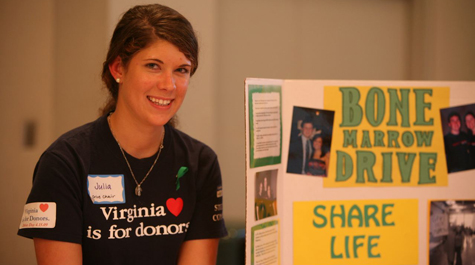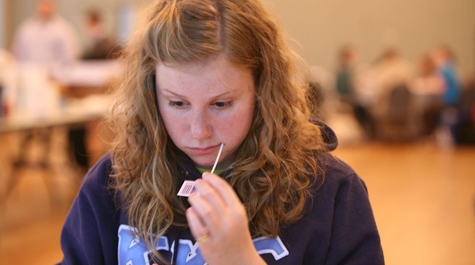Swab a cheek, save a life
"That's it?" she asked William & Mary Bone Marrow Drive Chair Julia Pentz ('09).
"That's it!" Pentz confirmed, and motioned the next student forward.
Brooks was one of about 600 people who were added to the national bone marrow donor registry this year thanks to William & Mary's annual drive. The drive began in 1991 as a way to find a potential match for a professor on campus, and it was continued by Jay Bukzin ('94), who was searching for a match for his brother, Alan.
Every year, more than 30,000 children and adults are diagnosed with fatal blood diseases like leukemia. In many instances, a bone marrow transplant is their only chance for a cure-but finding a match is easier said than done. Only 30 percent of patients that need a transplant find a matched donor within their family. More often than not, they are forced to turn to the National Marrow Donor Program's (NMDP) Registry of volunteer marrow donors. At any given time, more than 2,000 patients are searching the database in the hope of finding a lifesaving match.
Over the past 18 years, the William & Mary drive has registered over 12,000 people for the national registry, which led to over 275 matches and over 90 life-saving procedures. Last year alone six students were called as potential donors, of which three were matched and donated.
"The program has grown every year," said Pentz, who applied to be a part of the drive's steering committee after being called as a potential match. "In recent years we've added a number of events to make sure we're raising enough money to allow everyone to participate who wants to."
Though many continue to believe the William & Mary bone marrow drive's primary function is to hold its "drive day," the organization has expanded into a veritable fundraising machine. Though the cheek swab is a simple way to add someone to the registry, the test costs $52 per person. Each year, the drive hopes to add about 1,000 people to the national registry, meaning that they have to fundraise over $60,000 a year to allow participants to be entered at no cost to them.
For this year's drive, fundraising events began in November with wMTV Night and a silent auction, and continued throughout the year with major events like the Charter Day Gala and Mr. William & Mary.
Senior Whitley Aamodt has been a member of the drive's steering committee for two years, but still counts drive day as her favorite event.
"There's nothing like it," she explained. "It's the day we all come together, unified and we get to see the fruits of our efforts and make a positive impact on the lives of others."
Though the numbers of registrants continues to grow, the steering committee says that minorities such as African Americans, Asian/Pacific Islanders, Hispanics and Native Americans are overwhelmingly underrepresented in the national registry, giving them a one in a million chance of finding a match there. With only 30 percent of patients able to find matches within their own family, the other 70 percent face an uphill battle for survival.
"This year we made a really strong effort to reach out to multicultural organizations on campus," said Brandie Burris ('09), multicultural outreach chair. "Because bone marrow tissue types are inherited like skin and hair color, minorities must find matches within their own ethnicities."
Any person between the ages of 18 and 60 is eligible for testing. Since giving blood is no longer a requirement for being added to the national registry, those limitations do not apply to a donor's eligibility. According to Aamodt, it is far more likely for a potential donor to be turned down due to previous back injuries and surgeries, as well as heart problems.
"Almost every student who comes through those doors is able to be added to the National Registry," Aamodt said. "More importantly, they have a chance to save or greatly improve the quality of someone's life-and is there any better gift than that?"
 Skip to main content
Skip to main content


